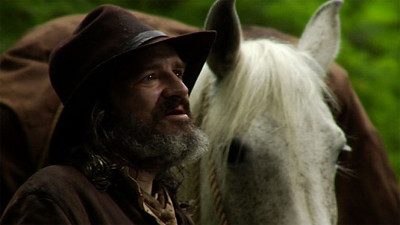
Video installation for 1 screen with numerous permutations
Image copyright David Zwirner
I really want to like Stan Douglas’s latest film Klatsassin currently on display at David Zwirner and a lot of this has to do with the fact that I spent three days in January decoding his similarly approached 2005 film Inconsolable Memories. But taking the good concepts of one film and simply exaggerating them in another rarely makes good work and Klatsassin is no exception.
Like Inconsolable memories, a film based on Tomás Gutiérrez Alea’s 1968 movie Memories of Underdevelopment, Douglas this time draws from Rashomon, a murder mystery told from several perspectives. Rashoman however told many stories in the space of 88 minutes, whereby Douglas teases his historical recount into a nearly 70 hour non-sequential narrative recounting trial and execution of the Aboriginal Tsilhoqot’in chief during the gold rush. Now, I’m not going to say that a confusing three day long piece is a liability to an artist (though it frequently is,) – the issue with the work stems more from the fact that there doesn’t appear to be any good reason for the length. As he did in Inconsolable Memories, the artist uses multiple reels to create the film thereby increasing its duration, only this time, rather than employ two he uses eight. Douglas can explain to you how he employed quick time videos to mix his many looping scenes, but it’s not very interesting, and seems rather excessive if the point is merely to create multiple stories.
But assuming you can figure the storyline out, there’s enough there to maintain the attention of the viewer. Not that it matters though, as the production issues are too great to ignore. For example, why go to the trouble to mimic cinematic conventions of picture composition and scenic transitions, if you’re not cast good actors? There wasn’t a soul in Klatsassin who uttered their lines convincingly, the wooden delivery reaching points so awful, I felt like leaving the room. The score also constituted an problematic element to the work as it frequently felt ill matched with the scenes. I suspect Douglas laid the music over the shots with some sort of algorithm that matched the film loops, but if the results have limited conceptual appeal, and aren’t any good formally, you might as well build greater structure into the sound design.
Much like the people we encounter every day, I guess you could ration that we’re not meant to respond to each scene in this film. The argument doesn’t go very far with me though because I’m not particularly interested in wasting my time waiting for a sequence I think works for me. And why should I bother? Stan Douglas said himself he hadn’t watched the movie in it’s entirety, and while it’s clearly not important to him that people stay for the three day duration, the statement would seem to indicate that the pleasure of figuring out the mechanics of the film were of greater importance than the experience of viewing it.


Comments on this entry are closed.